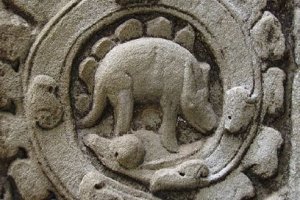by Eric Penz
A generation ago literature we label today as science fiction was simply fiction. Science fiction as a genre had not yet been born. Then seemingly over night “science fiction” burst onto the scene.
 Literature may be experiencing a similar phenomenon today. Just as science fiction’s roots can be traced back to the generation prior to its acceptance, as far back as Mary Shelley’s Frankenstein, a new genre may have roots nearly as old, dating back to Sir Arthur Conan Doyle’s Lost World and the original King Kong. Both of these titles were not considered separate from the rest of fiction in their day, but today they could be labeled within a new genre with strong ties to science fiction. Cryptofiction.
Literature may be experiencing a similar phenomenon today. Just as science fiction’s roots can be traced back to the generation prior to its acceptance, as far back as Mary Shelley’s Frankenstein, a new genre may have roots nearly as old, dating back to Sir Arthur Conan Doyle’s Lost World and the original King Kong. Both of these titles were not considered separate from the rest of fiction in their day, but today they could be labeled within a new genre with strong ties to science fiction. Cryptofiction.
Just as science seemed to have burst into the public’s consciousness at about the same time as the birth of science fiction, a new field of science is spawning a new genre of science fiction. Cryptozoology is a branch of science that studies cryptids, or unknown and as yet undiscovered species of animals. Not yet widely accepted by mainstream science, cryptozoology is nevertheless a self-styled and self-labeled field of study with a growing audience. The same can be said for cryptofiction.
The literature itself may have been with us since King Kong and beyond, but today there is a specific demand by readers for stories that explore new and hopefully deadly species. Michael Crichton’s Jurassic Park may be the contemporary father of cryptofiction. Since Crichton’s genetically engineered dinosaurs, readers have been to the Himalayas in search of Neanderthals and the yeti in John Darnton’s Neanderthal and Philip Kerr’s Esau; Steve Alten has terrified readers with megalodon sharks in Meg and giant eels in The Loch; and Frank Peretti has even gotten into the game with his twist on Bigfoot in Monster. And to further fuel the audience’s demand for such creepy cryptids, Peter Jackson recently reinvented King Kong, bringing the King of cryptofiction into the digital age and back to the silver screen where he was born.
Popular cryptozoologist, Loren Coleman, has even begun selecting his top and best titles of cryptofiction works each year. In 2005, such an honor went to Steve Alten’s The Loch and my own Cryptid: The Lost Legacy of Lewis & Clark. But if cryptofiction is here to stay as a real genre, what is the cause for this new demand on behalf of the reader? The answer may correlate with the degree to which humanity has sterilized and conquered the once wild and untamed planet earth. We seem to have beaten the mystery and wonder out of the world. Epic adventures such as those had by Lewis & Clark are forever banished to the history texts. No where on a map can one look and find the words terra incognito scrawled across a blank space depicting imagined dragons and beasts of legend instead of known and documented rivers, mountains and deserts.
Just because we conquered the earth, though, doesn’t mean our adventurous spirit has been conquered. The need to explore remains as strong as ever in the human heart. And it may be that one of the last frontiers on earth to explore is that of yet undiscovered species.
Cryptozoology and its literary manifestation then have come to life to fill an ancient and deep need of the human soul葉he need to explore. And until new worlds to tame and discover are brought into reach by science, the demand for cryptofiction will only increase. For it is both the authors’ and readers’ way of once again scrawling on a map the words: Terra Incognito. Here be monsters.
!
